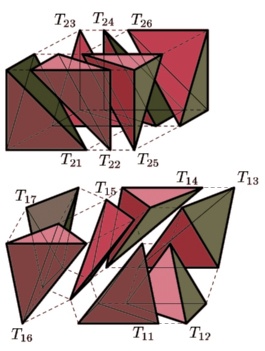|
|
|
|
Research project:
Maximal Commutative Subgroup Approximation
|
|

This project
studies topics which belong to both number theory and
discrete geometry: more specifically, we investigated generalizations of
concepts from Diophantine approximation. We followed a recently
established line of research which links the approximation of maximal
commutative subgroups on the one hand, and multidimensional continued
fractions on the other hand. The aim of this project was to create
efficient methodology concerning continued fractions in order to develop a
kind of "approximation theory" for geometric primitives (lines, planes,
simplicial cones, polyhedra) by rational objects defined in terms of
appropriate integer lattices). This approach combines different notions of
multidimensional continued fractions and their interpretation as maximal
commutative subgroups.
The results obtained in the project include the following: Firstly we
extended geometric Gauss reduction theory to the multidimensional case, in
particular obtaining a complete set of geometric invariants (in terms of
Klein-Voronoi continued fractions) of conjugacy classes of integer
matrices. Another result is fast algorithms for the computation of finite
Minkowski-Voronoi tessellations of the planes that correspond to rational
maximal commutative subgroups (in the 3D case). Finally we we developed
the approximation theory of arrangements of two 1-dimensional subspaces,
showing an analogue of Lagrange's theorem on approximation rates.
This research has connections to other branches of mathematics. One link
is to so-called limit shape problems of Young diagrams or convex lattice
polygons, when they are considered in the simplicial cone setting. Another
link is to the approximation by rational cones which correspond to
singularities of complex toric varieties.
See [here] for an earlier project page
on multidimensional continued fractions. Work on this project in the
years 2011–2013 was carried out at TU Graz.
|
| Publications |
-
O. Karpenkov.
Geometry of continued fractions.
Springer, 2013.
ISBN 978-3-642-39367-9.
[doi].
-
O. Karpenkov.
Multidimensional Gauss reduction theory for conjugacy classes of
SL(n,Z).
J. Th. Nombres Bordeaux 25 (2013), 99-109.
[MR], [doi].
-
O. Karpenkov and A. Ustinov.
Geometry of Minkowski-Voronoi tessellations of the plane.
Technical Report 1407.0135, ArXiv, 2014-2017.
[arxiv:1407.0135].
-
O. Karpenkov.
On asymptotic reducibility in SL(3,mathbb Z).
Technical Report 1205.4166, ArXiv, 2012.
[arxiv:1205.4166].
-
O. N. Karpenkov and A. M. Vershik.
Rational approximation of maximal commutative subgroups of GL(n,R).
J. Fixed Point Theory Appl. 7/1 (2010), 241-263.
[MR], [doi].
-
O. Karpenkov.
Continued fractions and the second Kepler law.
Manuscripta Mathematica 134 (2011), 157-169.
[MR], [doi], [arxiv:0911.2791].
-
O. Karpenkov.
On
determination of periods of geometric continued fractions for two-dimensional
algebraic hyperbolic operators.
Math. Notes 88/1-2 (2010), 28-38, Russian version: Mat.
Zametki, 88(1), (2010), 30--42.
[doi].
-
O. Karpenkov.
On
irrational lattice angles.
Funct. Anal. Other Math. 2/2-4 (2009), 221-239.
[Zbl], [MR], [doi].
-
O. Karpenkov.
Constructing multidimensional periodic continued fractions in the sense of
Klein.
Math. Comp. 78/267 (2009), 1687-1711.
[MR], [doi], [arxiv:math/0411031].
-
O. Karpenkov.
Elementary notions of lattice trigonometry.
Math. Scand. 102/2 (2008), 161-205.
[Zbl], [MR].
-
O. Karpenkov.
Completely empty pyramids on integer lattices and two-dimensional faces of
multidimensional continued fractions.
Monatsh. Math. 152/3 (2007), 217-249.
[Zbl], [MR], [doi], [arxiv:math/0510482].
-
O. Karpenkov.
On a
criterion for the existence and uniqueness of an integer triangle with given
angles.
Russian Math. Surveys 61/6 (2006), 1178-1179.
[Zbl], [MR], [doi].
-
O. Karpenkov.
Three
examples of three-dimensional continued fractions in the sense of
Klein.
C. R. Math. Acad. Sci. Paris 343/1 (2006), 5-7.
[Zbl], [MR], [doi], [arxiv:math/0601493].
-
O. Karpenkov.
Classification of three-dimensional multistoried completely hollow convex
marked pyramids.
Russian Math. Surveys 60 (2005), 165-166.
[Zbl], [MR], [doi].
-
O. Karpenkov.
On
two-dimensional continued fractions of hyperbolic integer matrices with small
norm.
Russian Math. Surveys 59/5 (2004), 959-960.
[Zbl], [MR], [doi].
-
O. Karpenkov.
On the
triangulations of tori associated with two-dimensional continued fractions of
cubic irrationalities.
Funct. Anal. Appl. 38/2 (2004), 102-110, Russian version:
Funkt. Anal. Prilozh. 38 (2004), 28-37.
[Zbl], [MR], [doi].
|
| Other References |
-
V. I. Arnold.
Continued fractions.
Moscow Center of Continuous Mathematical Education, Moscow, 2002.
-
V. I. Arnold.
Higher-dimensional continued fractions.
Regul. Chaotic Dyn. 3/3 (1998), 10-17, J. Moser at 70 (Russian).
[MR].
-
O. N. German.
Sails and Hilbert bases.
Tr. Mat. Inst. Steklova 239/Diskret. Geom. i Geom. Chisel
(2002), 98-105.
[MR].
-
F. Klein.
Ueber eine geometrische Auffassung der gewöhnlichen
Kettenbruchentwicklung.
Nachr. Ges. Wiss. Göttingen Math-Phys. Kl. 3/3 (1895),
352-357.
-
F. Klein.
Sur une représentation géométrique de développement en fraction
continue ordinaire.
Nouv. Ann. Math. 15/3 (1896), 327-331.
-
M. L. Kontsevich and Y. M. Suhov.
Statistics of Klein polyhedra and multidimensional continued fractions.
In Pseudoperiodic topology, volume 197 of Amer. Math. Soc. Transl.
Ser. 2, pages 9-27. Amer. Math. Soc., Providence, RI, 1999.
[MR].
-
E. I. Korkina.
The simplest 2-dimensional continued fraction.
J. Math. Sci. 82/5 (1996), 3680-3685, Topology, 3.
[MR].
-
E. I. Korkina.
Two-dimensional continued fractions. The simplest examples.
Trudy Mat. Inst. Steklov. 209/Osob. Gladkikh Otobrazh. s Dop.
Strukt. (1995), 143-166.
[MR].
-
E. Korkina.
La périodicité des fractions continues multidimensionnelles.
C. R. Acad. Sci. Paris Sér. I Math. 319/8 (1994), 777-780.
[MR].
-
G. Lachaud.
Voiles et polyhedres de Klein.
Act. Sci. Ind. Hermann, 2002.
176 pp.
-
Z.-O. Mussafir.
Sails and Hilbert bases.
Funktsional. Anal. i Prilozhen. 34/2 (2000), 43-49, 96.
[MR].
-
H. Tsuchihashi.
Higher-dimensional analogues of periodic continued fractions and cusp
singularities.
Tohoku Math. J. (2) 35/4 (1983), 607-639.
[MR].
|

